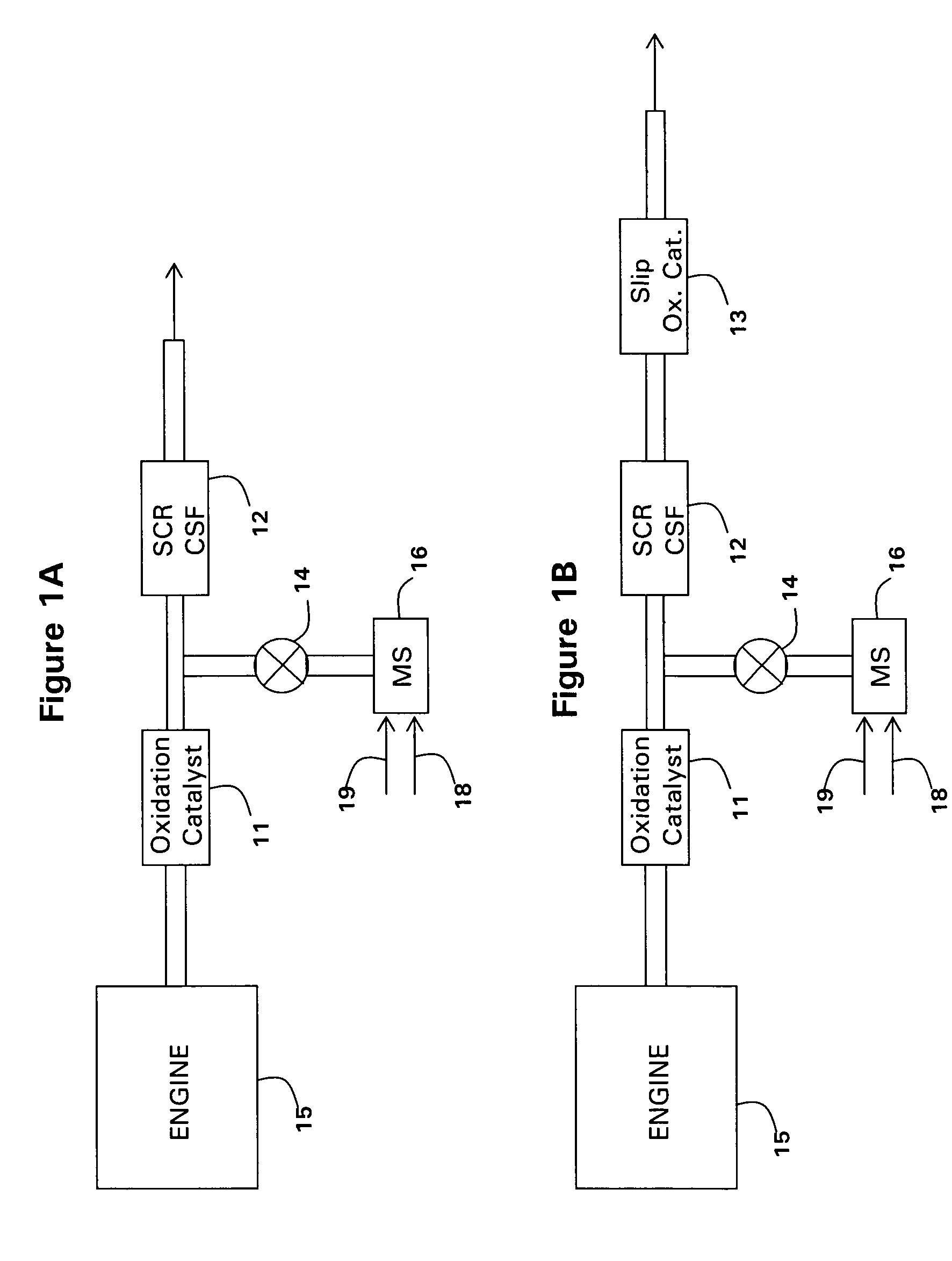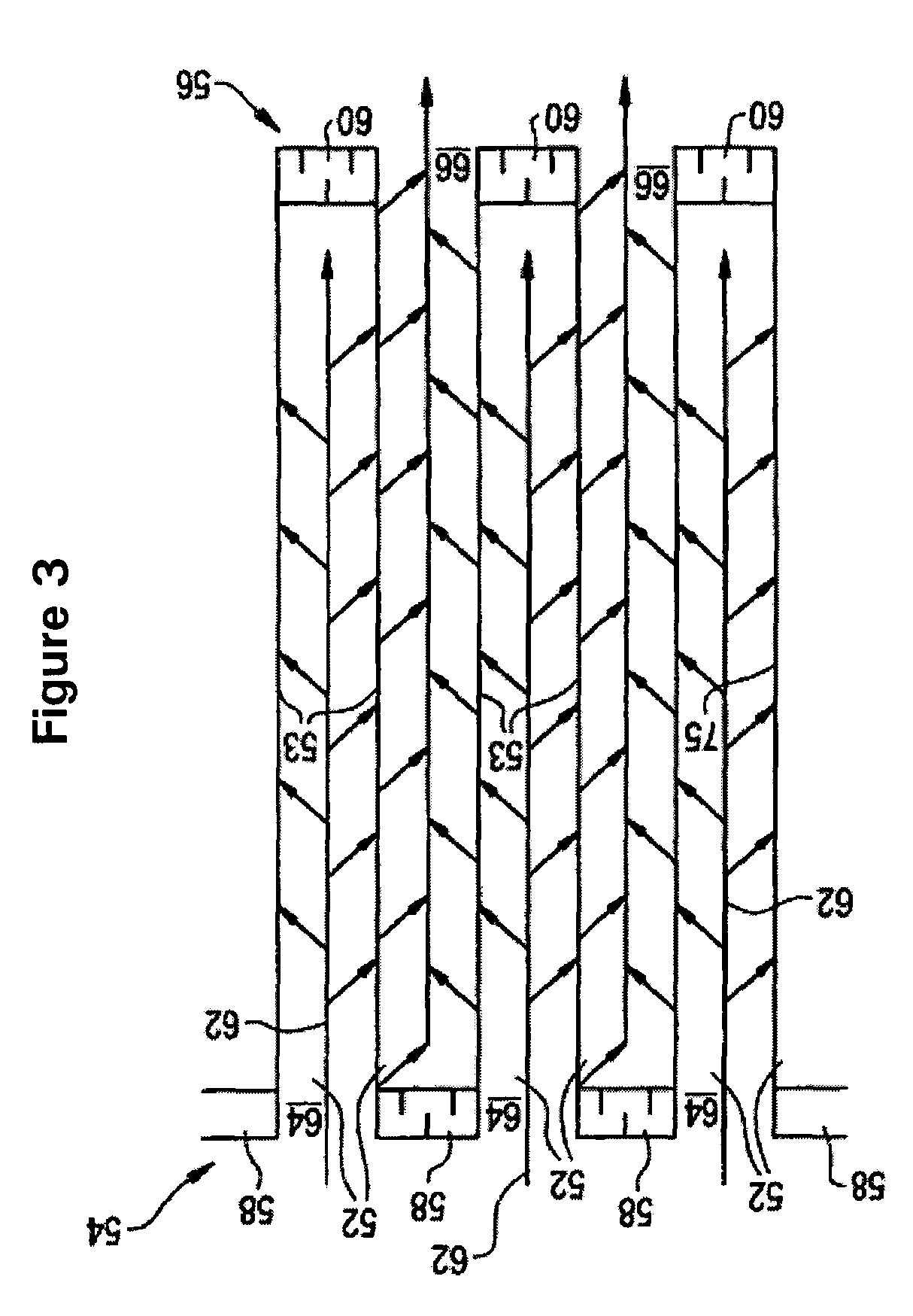Catalyzed SCR filter and emission treatment system
a technology of emission treatment system and scr filter, which is applied in the direction of catalyst activation/preparation, machine/engine, surface covering, etc., can solve the problems of unacceptably high back pressure within the exhaust system, carbon soot particles that require temperatures in excess of 500° c. to burn, and the catalytic effect of commonly used scr catalyst compositions such as mixed oxides of vanadium and titanium is less
- Summary
- Abstract
- Description
- Claims
- Application Information
AI Technical Summary
Benefits of technology
Problems solved by technology
Method used
Image
Examples
example 1
Coating of Ceramic Wall Flow Filters
[0074]Cordierite ceramic wall flow filter substrates (product name C611, NGK Insulators, Ltd.) having dimensions of 5.66×6 inches, a wall thickness of 0.012 in, an average pore size of 25 microns and 60% wall porosity were used to prepare catalyst-coated soot filters.
[0075]A catalyst slurry containing 27% by weight solids content was formed from copper-exchanged beta zeolite (containing 2 wt. % of copper), additional CuSO4 (sufficient to provide 9.5 wt. % of copper), and 7 wt. % ZrO2 and de-ionized water (wt. % based on the weight of the beta zeolite). The copper-exchanged beta zeolite was prepared as in U.S. Pat. No. 5,516,497.
[0076]An identical procedure was used to prepare two of the filter substrates according to a preferred embodiment of the invention. The wall flow substrate was:
[0077](1) dipped into the slurry to a depth sufficient to coat the channels of the substrate along the entire axial length of the substrate from one direction;
[0078]...
example 2
Evaluation of Back Pressures for Coated Soot Filters
[0085]The pressure drop across the uncoated and coated filters was evaluated using the commercially available automated equipment, Super Flow SF 1020, (Probench). This equipment is designed specifically for measuring pressure drops as a function of air flow. Data from this equipment provides a plot of the pressure drop at ambient conditions as a function of the air flow. The pressure drop is a measure of how easily air flows through the filter. In diesel engine applications, lower pressure drops are desirable since the engine must expend power to move the air. Therefore, the larger the pressure drop, the greater the amount of engine power that is lost to pumping air. This lost power reduces the engine power that is available to the wheels.
[0086]FIG. 5 summarizes the pressure drop across the coated filters, Catalyst A1, A2 and B1, as well as an uncoated filter of the identical dimensions. The filters coated according to Steps (1) th...
example 3
Demonstration of Particulate Removal by the SCR Catalyst
[0087]When applied to the wall flow filter, the catalyst composition should ideally aid in the regeneration of the filter. Therefore, the SCR catalyst composition disposed on the filter is preferably able to catalyze the oxidation of soot and VOF portions of the particulate. To be effective in reducing NOx and particulate mass the SCR catalyst should preferably not oxidize ammonia or SO2 to make SO3. One way of evaluating a catalyst's ability to oxidize carbon and VOF is by the use of combined Thermal Gravimetric Analysis (TGA) and Differential Thermal Analysis (DTA). The TGA measures the weight loss of a sample while the DTA measures the change in sample's heat capacity versus a reference. In this experiment, a dried and calcined portion of the catalyst slurry was mixed with 6% by weightfube oil, to simulate the VOF portion of the lube, and 14% by weight carbon black, to simulate the soot fraction of the particulate. The mixtu...
PUM
| Property | Measurement | Unit |
|---|---|---|
| concentration | aaaaa | aaaaa |
| pore size | aaaaa | aaaaa |
| porosity | aaaaa | aaaaa |
Abstract
Description
Claims
Application Information
 Login to View More
Login to View More - R&D
- Intellectual Property
- Life Sciences
- Materials
- Tech Scout
- Unparalleled Data Quality
- Higher Quality Content
- 60% Fewer Hallucinations
Browse by: Latest US Patents, China's latest patents, Technical Efficacy Thesaurus, Application Domain, Technology Topic, Popular Technical Reports.
© 2025 PatSnap. All rights reserved.Legal|Privacy policy|Modern Slavery Act Transparency Statement|Sitemap|About US| Contact US: help@patsnap.com



